Essay: Cooperative Societies, Types, Benefits, and Key Elements
VerifiedAdded on 2022/07/28
|11
|2983
|199
Essay
AI Summary
This essay provides a comprehensive overview of cooperative societies, exploring their various types, including financial, producer, consumer, agricultural, and service cooperatives. It delves into the key elements that characterize cooperatives, such as ownership, management, capital and liability, legal status, and registration. The essay also highlights the advantages of cooperatives, such as ease of establishment, open membership, democratic management, limited liability, and financial operations, while also addressing their disadvantages, including limited capital, inefficient management, and lack of competition. Furthermore, the essay emphasizes the importance of training and development, staff strengthening, and legal compliance for the successful functioning of cooperatives, concluding with the essential elements and developmental measures required for their effective operation.
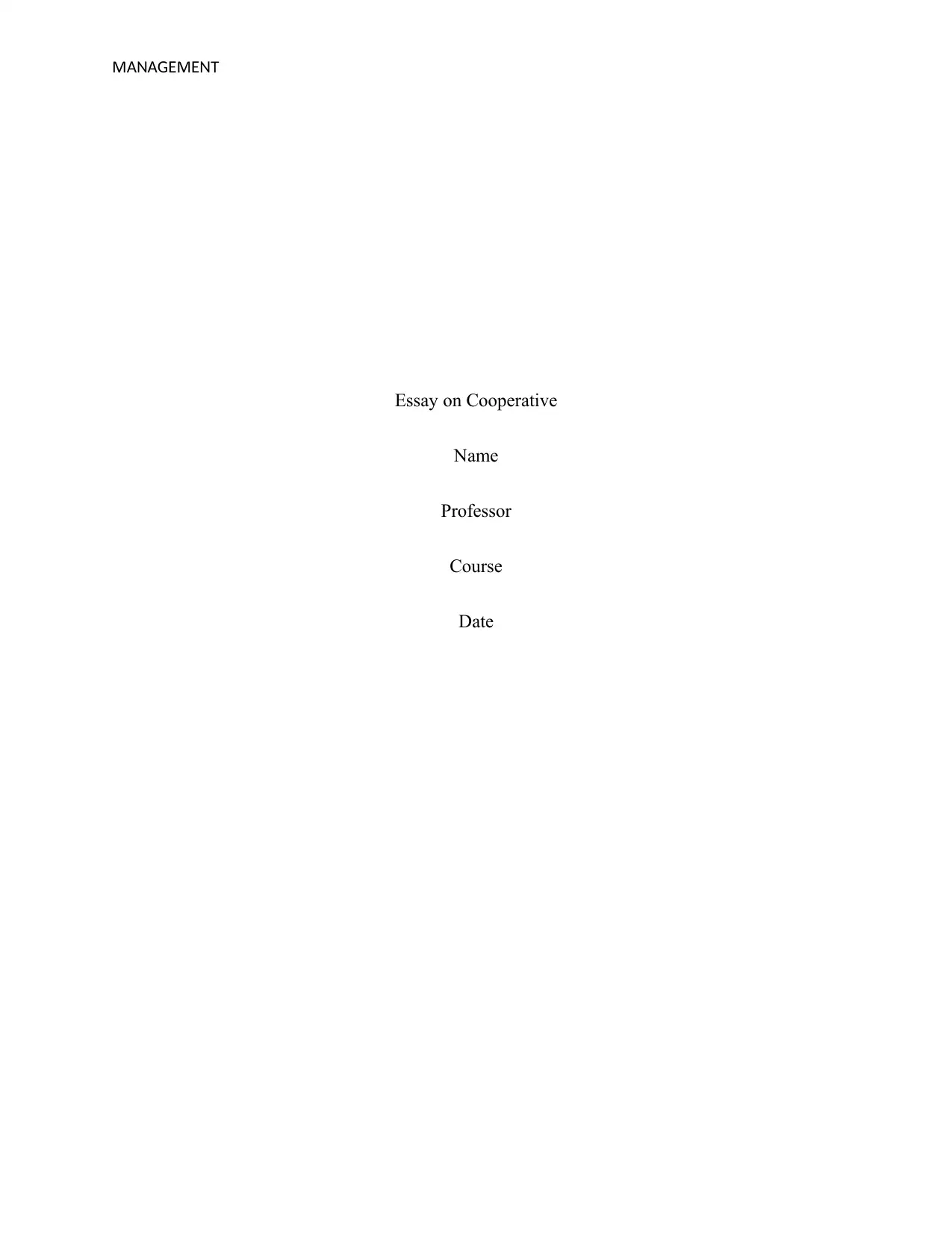
M M TANAGE EN
Essay on Cooperative
Name
Professor
Course
Date
Essay on Cooperative
Name
Professor
Course
Date
Paraphrase This Document
Need a fresh take? Get an instant paraphrase of this document with our AI Paraphraser
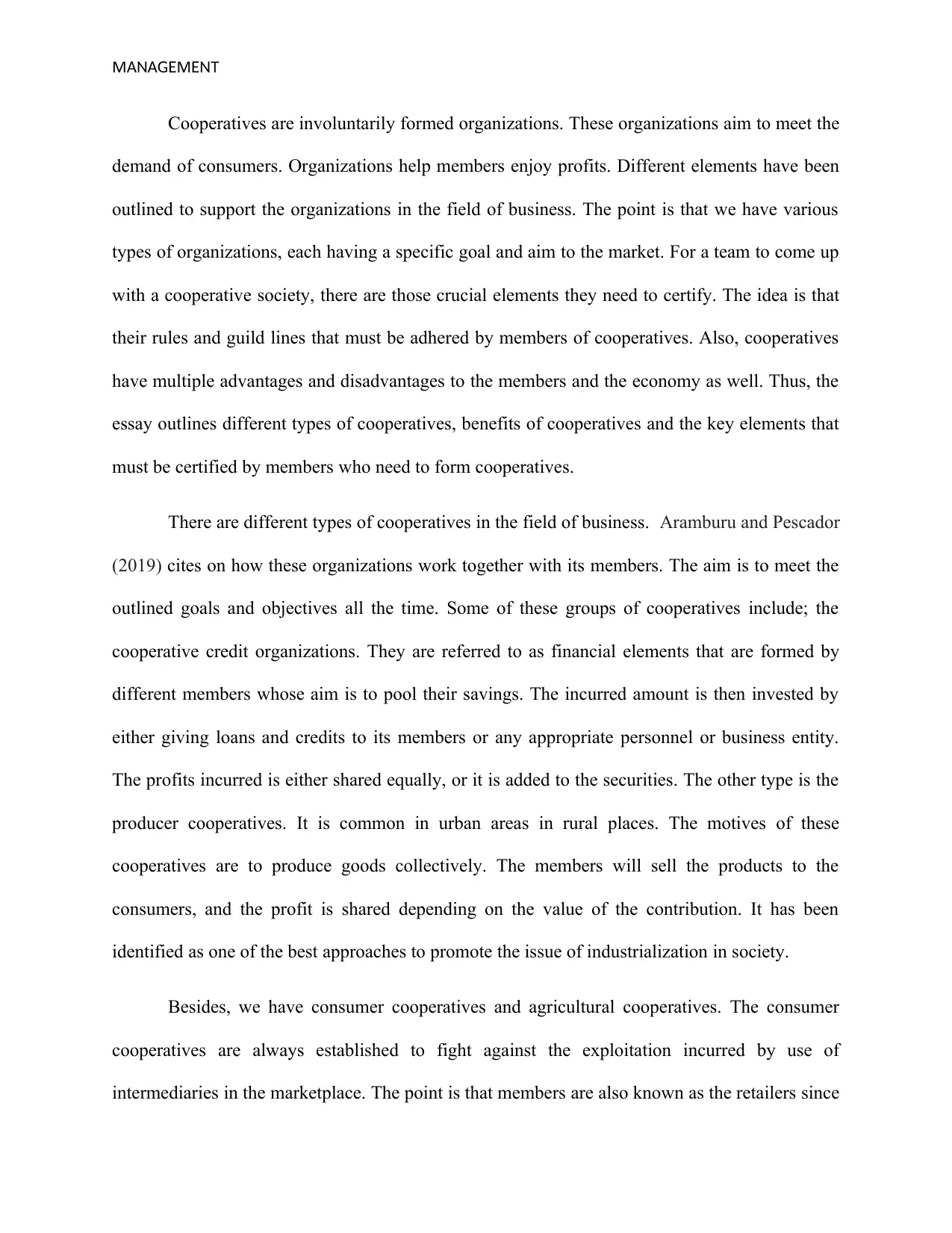
M M TANAGE EN
Cooperatives are involuntarily formed organizations. These organizations aim to meet the
demand of consumers. Organizations help members enjoy profits. Different elements have been
outlined to support the organizations in the field of business. The point is that we have various
types of organizations, each having a specific goal and aim to the market. For a team to come up
with a cooperative society, there are those crucial elements they need to certify. The idea is that
their rules and guild lines that must be adhered by members of cooperatives. Also, cooperatives
have multiple advantages and disadvantages to the members and the economy as well. Thus, the
essay outlines different types of cooperatives, benefits of cooperatives and the key elements that
must be certified by members who need to form cooperatives.
There are different types of cooperatives in the field of business. Aramburu and Pescador
(2019) cites on how these organizations work together with its members. The aim is to meet the
outlined goals and objectives all the time. Some of these groups of cooperatives include; the
cooperative credit organizations. They are referred to as financial elements that are formed by
different members whose aim is to pool their savings. The incurred amount is then invested by
either giving loans and credits to its members or any appropriate personnel or business entity.
The profits incurred is either shared equally, or it is added to the securities. The other type is the
producer cooperatives. It is common in urban areas in rural places. The motives of these
cooperatives are to produce goods collectively. The members will sell the products to the
consumers, and the profit is shared depending on the value of the contribution. It has been
identified as one of the best approaches to promote the issue of industrialization in society.
Besides, we have consumer cooperatives and agricultural cooperatives. The consumer
cooperatives are always established to fight against the exploitation incurred by use of
intermediaries in the marketplace. The point is that members are also known as the retailers since
Cooperatives are involuntarily formed organizations. These organizations aim to meet the
demand of consumers. Organizations help members enjoy profits. Different elements have been
outlined to support the organizations in the field of business. The point is that we have various
types of organizations, each having a specific goal and aim to the market. For a team to come up
with a cooperative society, there are those crucial elements they need to certify. The idea is that
their rules and guild lines that must be adhered by members of cooperatives. Also, cooperatives
have multiple advantages and disadvantages to the members and the economy as well. Thus, the
essay outlines different types of cooperatives, benefits of cooperatives and the key elements that
must be certified by members who need to form cooperatives.
There are different types of cooperatives in the field of business. Aramburu and Pescador
(2019) cites on how these organizations work together with its members. The aim is to meet the
outlined goals and objectives all the time. Some of these groups of cooperatives include; the
cooperative credit organizations. They are referred to as financial elements that are formed by
different members whose aim is to pool their savings. The incurred amount is then invested by
either giving loans and credits to its members or any appropriate personnel or business entity.
The profits incurred is either shared equally, or it is added to the securities. The other type is the
producer cooperatives. It is common in urban areas in rural places. The motives of these
cooperatives are to produce goods collectively. The members will sell the products to the
consumers, and the profit is shared depending on the value of the contribution. It has been
identified as one of the best approaches to promote the issue of industrialization in society.
Besides, we have consumer cooperatives and agricultural cooperatives. The consumer
cooperatives are always established to fight against the exploitation incurred by use of
intermediaries in the marketplace. The point is that members are also known as the retailers since
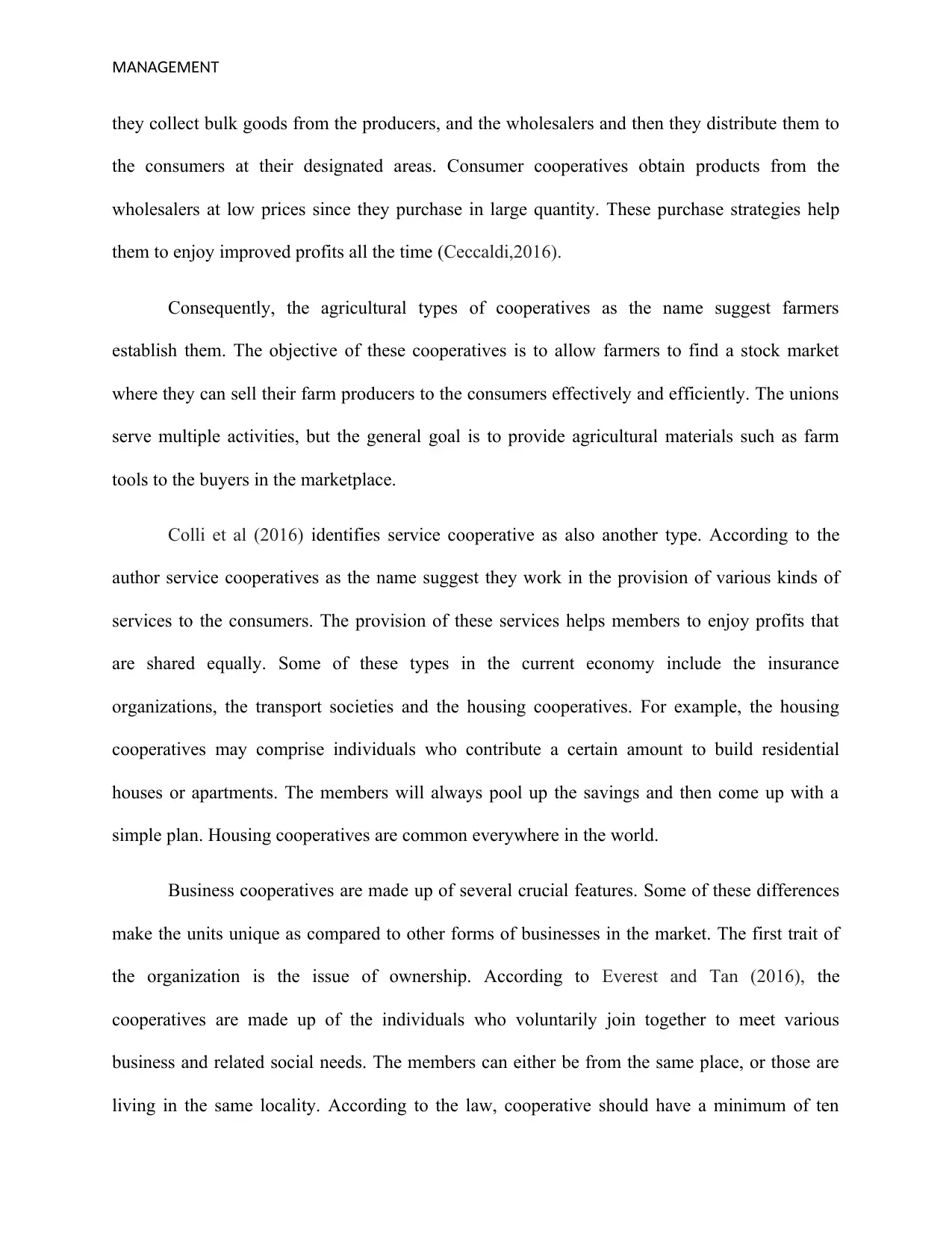
M M TANAGE EN
they collect bulk goods from the producers, and the wholesalers and then they distribute them to
the consumers at their designated areas. Consumer cooperatives obtain products from the
wholesalers at low prices since they purchase in large quantity. These purchase strategies help
them to enjoy improved profits all the time (Ceccaldi,2016).
Consequently, the agricultural types of cooperatives as the name suggest farmers
establish them. The objective of these cooperatives is to allow farmers to find a stock market
where they can sell their farm producers to the consumers effectively and efficiently. The unions
serve multiple activities, but the general goal is to provide agricultural materials such as farm
tools to the buyers in the marketplace.
Colli et al (2016) identifies service cooperative as also another type. According to the
author service cooperatives as the name suggest they work in the provision of various kinds of
services to the consumers. The provision of these services helps members to enjoy profits that
are shared equally. Some of these types in the current economy include the insurance
organizations, the transport societies and the housing cooperatives. For example, the housing
cooperatives may comprise individuals who contribute a certain amount to build residential
houses or apartments. The members will always pool up the savings and then come up with a
simple plan. Housing cooperatives are common everywhere in the world.
Business cooperatives are made up of several crucial features. Some of these differences
make the units unique as compared to other forms of businesses in the market. The first trait of
the organization is the issue of ownership. According to Everest and Tan (2016), the
cooperatives are made up of the individuals who voluntarily join together to meet various
business and related social needs. The members can either be from the same place, or those are
living in the same locality. According to the law, cooperative should have a minimum of ten
they collect bulk goods from the producers, and the wholesalers and then they distribute them to
the consumers at their designated areas. Consumer cooperatives obtain products from the
wholesalers at low prices since they purchase in large quantity. These purchase strategies help
them to enjoy improved profits all the time (Ceccaldi,2016).
Consequently, the agricultural types of cooperatives as the name suggest farmers
establish them. The objective of these cooperatives is to allow farmers to find a stock market
where they can sell their farm producers to the consumers effectively and efficiently. The unions
serve multiple activities, but the general goal is to provide agricultural materials such as farm
tools to the buyers in the marketplace.
Colli et al (2016) identifies service cooperative as also another type. According to the
author service cooperatives as the name suggest they work in the provision of various kinds of
services to the consumers. The provision of these services helps members to enjoy profits that
are shared equally. Some of these types in the current economy include the insurance
organizations, the transport societies and the housing cooperatives. For example, the housing
cooperatives may comprise individuals who contribute a certain amount to build residential
houses or apartments. The members will always pool up the savings and then come up with a
simple plan. Housing cooperatives are common everywhere in the world.
Business cooperatives are made up of several crucial features. Some of these differences
make the units unique as compared to other forms of businesses in the market. The first trait of
the organization is the issue of ownership. According to Everest and Tan (2016), the
cooperatives are made up of the individuals who voluntarily join together to meet various
business and related social needs. The members can either be from the same place, or those are
living in the same locality. According to the law, cooperative should have a minimum of ten
⊘ This is a preview!⊘
Do you want full access?
Subscribe today to unlock all pages.

Trusted by 1+ million students worldwide
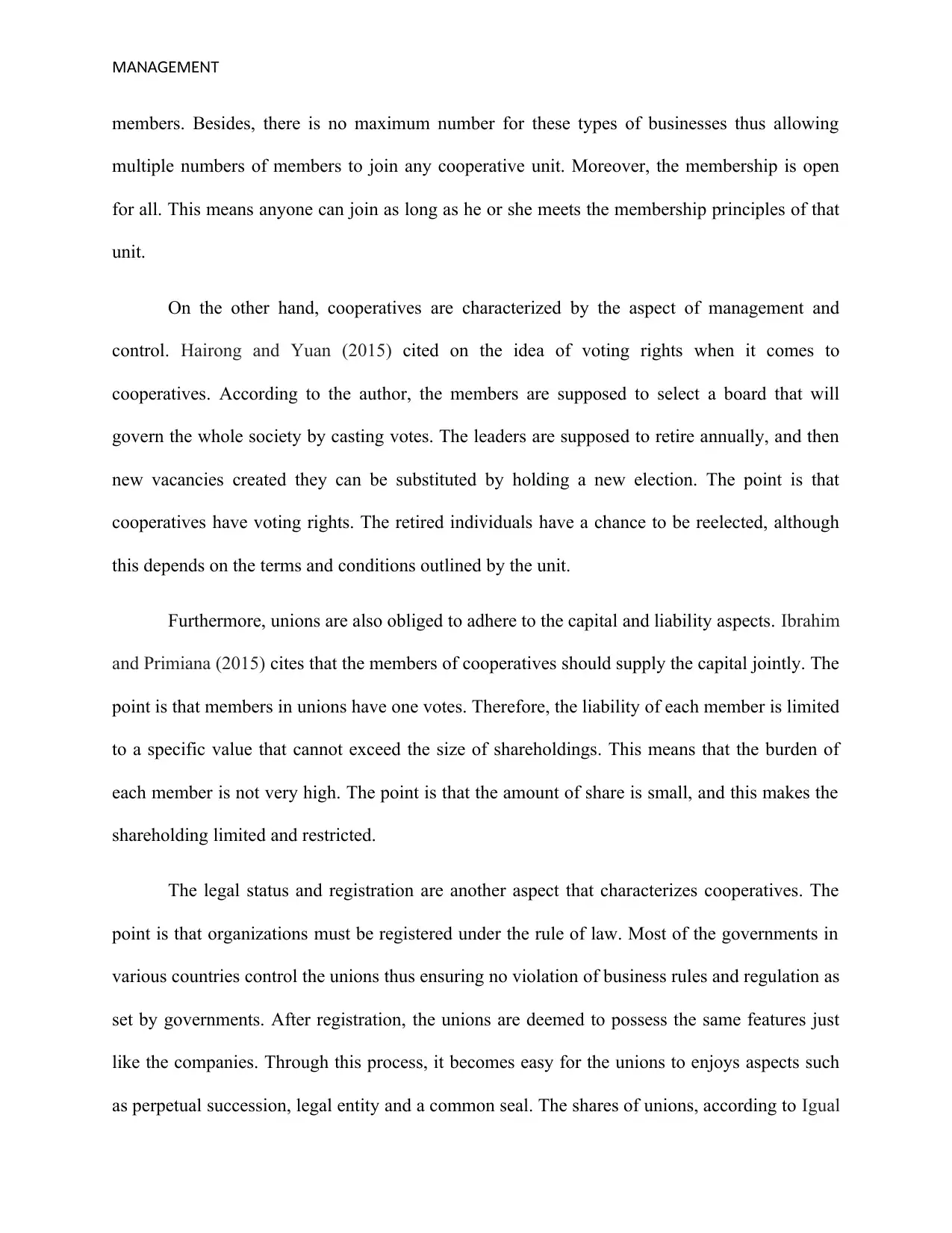
M M TANAGE EN
members. Besides, there is no maximum number for these types of businesses thus allowing
multiple numbers of members to join any cooperative unit. Moreover, the membership is open
for all. This means anyone can join as long as he or she meets the membership principles of that
unit.
On the other hand, cooperatives are characterized by the aspect of management and
control. Hairong and Yuan (2015) cited on the idea of voting rights when it comes to
cooperatives. According to the author, the members are supposed to select a board that will
govern the whole society by casting votes. The leaders are supposed to retire annually, and then
new vacancies created they can be substituted by holding a new election. The point is that
cooperatives have voting rights. The retired individuals have a chance to be reelected, although
this depends on the terms and conditions outlined by the unit.
Furthermore, unions are also obliged to adhere to the capital and liability aspects. Ibrahim
and Primiana (2015) cites that the members of cooperatives should supply the capital jointly. The
point is that members in unions have one votes. Therefore, the liability of each member is limited
to a specific value that cannot exceed the size of shareholdings. This means that the burden of
each member is not very high. The point is that the amount of share is small, and this makes the
shareholding limited and restricted.
The legal status and registration are another aspect that characterizes cooperatives. The
point is that organizations must be registered under the rule of law. Most of the governments in
various countries control the unions thus ensuring no violation of business rules and regulation as
set by governments. After registration, the unions are deemed to possess the same features just
like the companies. Through this process, it becomes easy for the unions to enjoys aspects such
as perpetual succession, legal entity and a common seal. The shares of unions, according to Igual
members. Besides, there is no maximum number for these types of businesses thus allowing
multiple numbers of members to join any cooperative unit. Moreover, the membership is open
for all. This means anyone can join as long as he or she meets the membership principles of that
unit.
On the other hand, cooperatives are characterized by the aspect of management and
control. Hairong and Yuan (2015) cited on the idea of voting rights when it comes to
cooperatives. According to the author, the members are supposed to select a board that will
govern the whole society by casting votes. The leaders are supposed to retire annually, and then
new vacancies created they can be substituted by holding a new election. The point is that
cooperatives have voting rights. The retired individuals have a chance to be reelected, although
this depends on the terms and conditions outlined by the unit.
Furthermore, unions are also obliged to adhere to the capital and liability aspects. Ibrahim
and Primiana (2015) cites that the members of cooperatives should supply the capital jointly. The
point is that members in unions have one votes. Therefore, the liability of each member is limited
to a specific value that cannot exceed the size of shareholdings. This means that the burden of
each member is not very high. The point is that the amount of share is small, and this makes the
shareholding limited and restricted.
The legal status and registration are another aspect that characterizes cooperatives. The
point is that organizations must be registered under the rule of law. Most of the governments in
various countries control the unions thus ensuring no violation of business rules and regulation as
set by governments. After registration, the unions are deemed to possess the same features just
like the companies. Through this process, it becomes easy for the unions to enjoys aspects such
as perpetual succession, legal entity and a common seal. The shares of unions, according to Igual
Paraphrase This Document
Need a fresh take? Get an instant paraphrase of this document with our AI Paraphraser
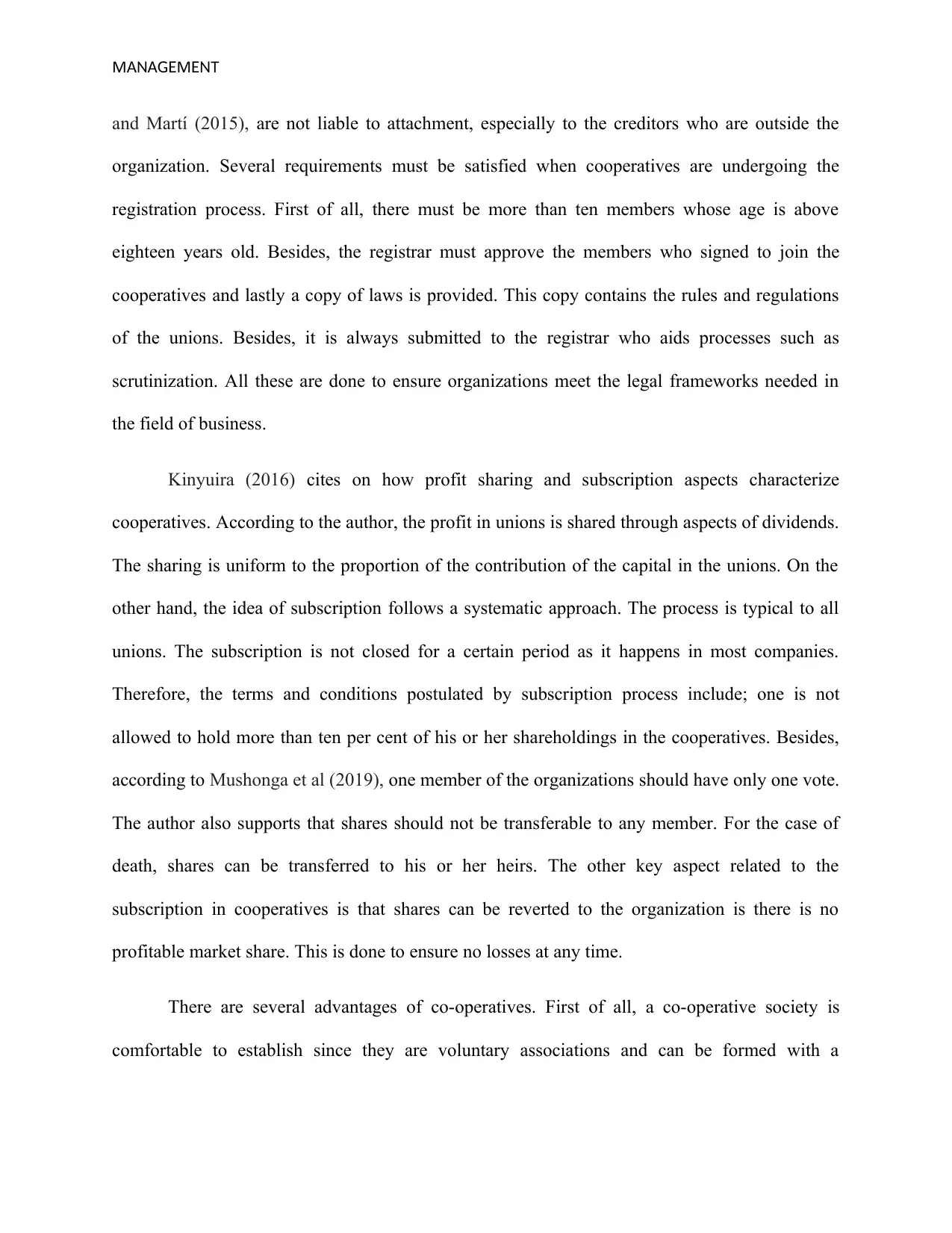
M M TANAGE EN
and Martí (2015), are not liable to attachment, especially to the creditors who are outside the
organization. Several requirements must be satisfied when cooperatives are undergoing the
registration process. First of all, there must be more than ten members whose age is above
eighteen years old. Besides, the registrar must approve the members who signed to join the
cooperatives and lastly a copy of laws is provided. This copy contains the rules and regulations
of the unions. Besides, it is always submitted to the registrar who aids processes such as
scrutinization. All these are done to ensure organizations meet the legal frameworks needed in
the field of business.
Kinyuira (2016) cites on how profit sharing and subscription aspects characterize
cooperatives. According to the author, the profit in unions is shared through aspects of dividends.
The sharing is uniform to the proportion of the contribution of the capital in the unions. On the
other hand, the idea of subscription follows a systematic approach. The process is typical to all
unions. The subscription is not closed for a certain period as it happens in most companies.
Therefore, the terms and conditions postulated by subscription process include; one is not
allowed to hold more than ten per cent of his or her shareholdings in the cooperatives. Besides,
according to Mushonga et al (2019), one member of the organizations should have only one vote.
The author also supports that shares should not be transferable to any member. For the case of
death, shares can be transferred to his or her heirs. The other key aspect related to the
subscription in cooperatives is that shares can be reverted to the organization is there is no
profitable market share. This is done to ensure no losses at any time.
There are several advantages of co-operatives. First of all, a co-operative society is
comfortable to establish since they are voluntary associations and can be formed with a
and Martí (2015), are not liable to attachment, especially to the creditors who are outside the
organization. Several requirements must be satisfied when cooperatives are undergoing the
registration process. First of all, there must be more than ten members whose age is above
eighteen years old. Besides, the registrar must approve the members who signed to join the
cooperatives and lastly a copy of laws is provided. This copy contains the rules and regulations
of the unions. Besides, it is always submitted to the registrar who aids processes such as
scrutinization. All these are done to ensure organizations meet the legal frameworks needed in
the field of business.
Kinyuira (2016) cites on how profit sharing and subscription aspects characterize
cooperatives. According to the author, the profit in unions is shared through aspects of dividends.
The sharing is uniform to the proportion of the contribution of the capital in the unions. On the
other hand, the idea of subscription follows a systematic approach. The process is typical to all
unions. The subscription is not closed for a certain period as it happens in most companies.
Therefore, the terms and conditions postulated by subscription process include; one is not
allowed to hold more than ten per cent of his or her shareholdings in the cooperatives. Besides,
according to Mushonga et al (2019), one member of the organizations should have only one vote.
The author also supports that shares should not be transferable to any member. For the case of
death, shares can be transferred to his or her heirs. The other key aspect related to the
subscription in cooperatives is that shares can be reverted to the organization is there is no
profitable market share. This is done to ensure no losses at any time.
There are several advantages of co-operatives. First of all, a co-operative society is
comfortable to establish since they are voluntary associations and can be formed with a
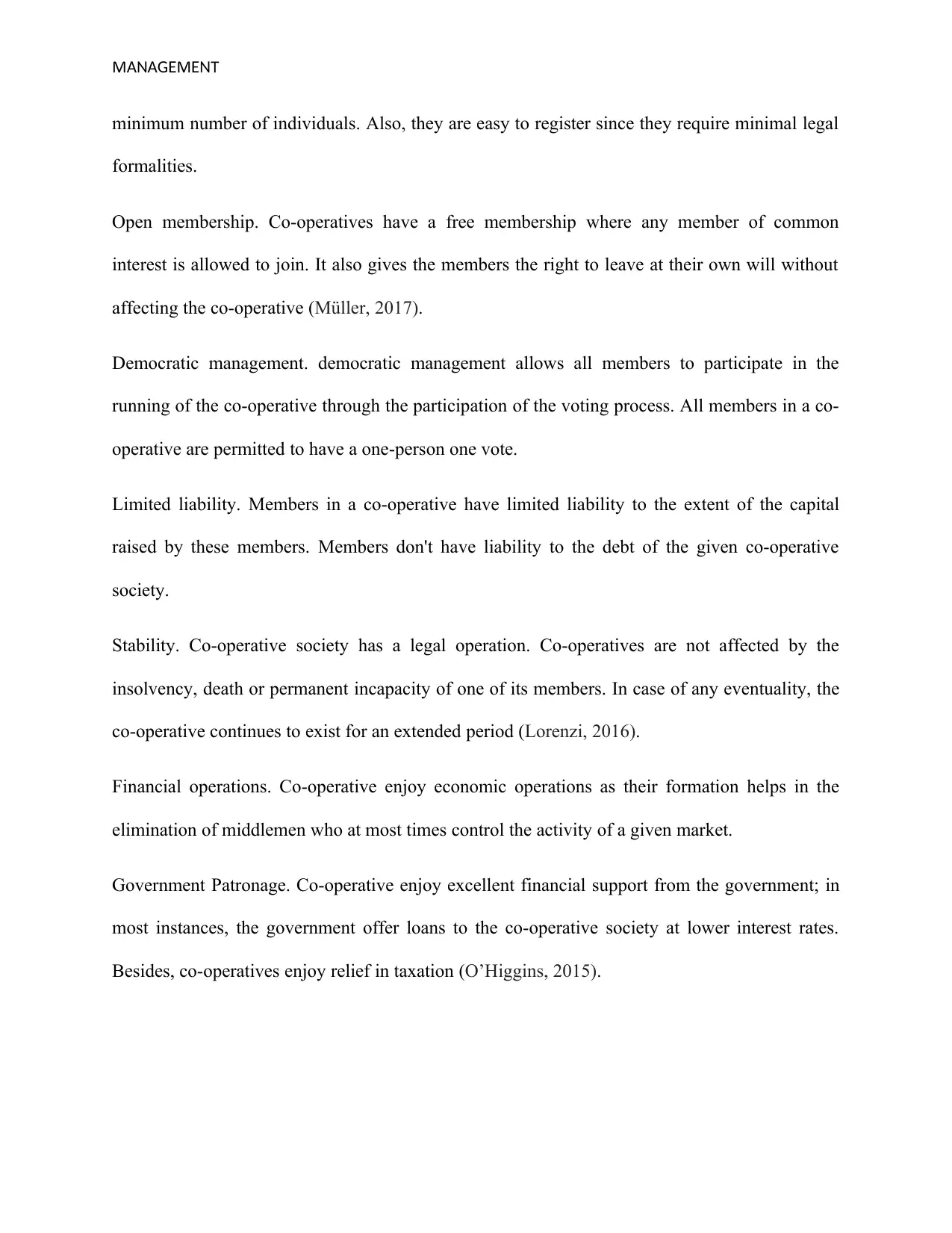
M M TANAGE EN
minimum number of individuals. Also, they are easy to register since they require minimal legal
formalities.
Open membership. Co-operatives have a free membership where any member of common
interest is allowed to join. It also gives the members the right to leave at their own will without
affecting the co-operative (Müller, 2017).
Democratic management. democratic management allows all members to participate in the
running of the co-operative through the participation of the voting process. All members in a co-
operative are permitted to have a one-person one vote.
Limited liability. Members in a co-operative have limited liability to the extent of the capital
raised by these members. Members don't have liability to the debt of the given co-operative
society.
Stability. Co-operative society has a legal operation. Co-operatives are not affected by the
insolvency, death or permanent incapacity of one of its members. In case of any eventuality, the
co-operative continues to exist for an extended period (Lorenzi, 2016).
Financial operations. Co-operative enjoy economic operations as their formation helps in the
elimination of middlemen who at most times control the activity of a given market.
Government Patronage. Co-operative enjoy excellent financial support from the government; in
most instances, the government offer loans to the co-operative society at lower interest rates.
Besides, co-operatives enjoy relief in taxation (O’Higgins, 2015).
minimum number of individuals. Also, they are easy to register since they require minimal legal
formalities.
Open membership. Co-operatives have a free membership where any member of common
interest is allowed to join. It also gives the members the right to leave at their own will without
affecting the co-operative (Müller, 2017).
Democratic management. democratic management allows all members to participate in the
running of the co-operative through the participation of the voting process. All members in a co-
operative are permitted to have a one-person one vote.
Limited liability. Members in a co-operative have limited liability to the extent of the capital
raised by these members. Members don't have liability to the debt of the given co-operative
society.
Stability. Co-operative society has a legal operation. Co-operatives are not affected by the
insolvency, death or permanent incapacity of one of its members. In case of any eventuality, the
co-operative continues to exist for an extended period (Lorenzi, 2016).
Financial operations. Co-operative enjoy economic operations as their formation helps in the
elimination of middlemen who at most times control the activity of a given market.
Government Patronage. Co-operative enjoy excellent financial support from the government; in
most instances, the government offer loans to the co-operative society at lower interest rates.
Besides, co-operatives enjoy relief in taxation (O’Higgins, 2015).
⊘ This is a preview!⊘
Do you want full access?
Subscribe today to unlock all pages.

Trusted by 1+ million students worldwide
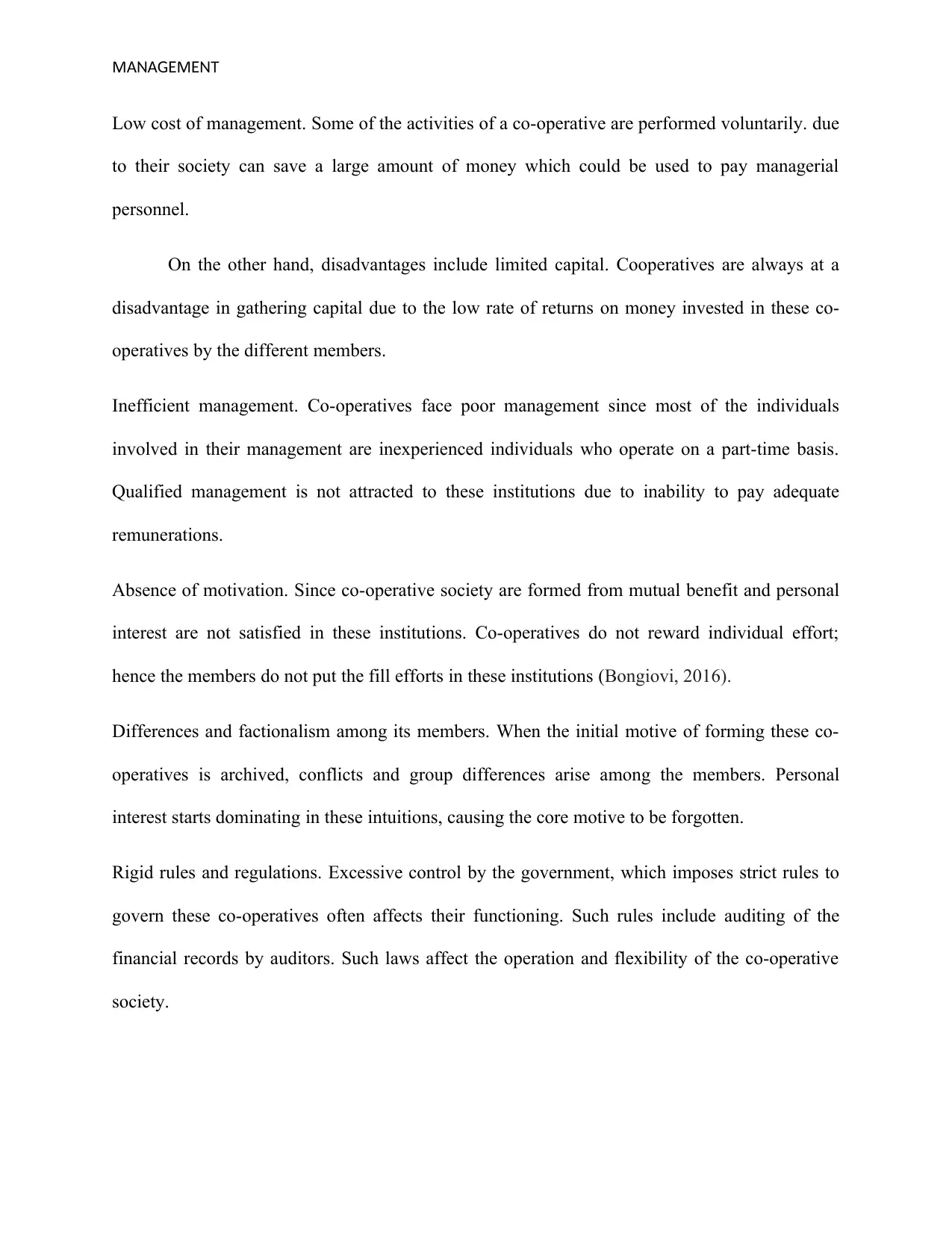
M M TANAGE EN
Low cost of management. Some of the activities of a co-operative are performed voluntarily. due
to their society can save a large amount of money which could be used to pay managerial
personnel.
On the other hand, disadvantages include limited capital. Cooperatives are always at a
disadvantage in gathering capital due to the low rate of returns on money invested in these co-
operatives by the different members.
Inefficient management. Co-operatives face poor management since most of the individuals
involved in their management are inexperienced individuals who operate on a part-time basis.
Qualified management is not attracted to these institutions due to inability to pay adequate
remunerations.
Absence of motivation. Since co-operative society are formed from mutual benefit and personal
interest are not satisfied in these institutions. Co-operatives do not reward individual effort;
hence the members do not put the fill efforts in these institutions (Bongiovi, 2016).
Differences and factionalism among its members. When the initial motive of forming these co-
operatives is archived, conflicts and group differences arise among the members. Personal
interest starts dominating in these intuitions, causing the core motive to be forgotten.
Rigid rules and regulations. Excessive control by the government, which imposes strict rules to
govern these co-operatives often affects their functioning. Such rules include auditing of the
financial records by auditors. Such laws affect the operation and flexibility of the co-operative
society.
Low cost of management. Some of the activities of a co-operative are performed voluntarily. due
to their society can save a large amount of money which could be used to pay managerial
personnel.
On the other hand, disadvantages include limited capital. Cooperatives are always at a
disadvantage in gathering capital due to the low rate of returns on money invested in these co-
operatives by the different members.
Inefficient management. Co-operatives face poor management since most of the individuals
involved in their management are inexperienced individuals who operate on a part-time basis.
Qualified management is not attracted to these institutions due to inability to pay adequate
remunerations.
Absence of motivation. Since co-operative society are formed from mutual benefit and personal
interest are not satisfied in these institutions. Co-operatives do not reward individual effort;
hence the members do not put the fill efforts in these institutions (Bongiovi, 2016).
Differences and factionalism among its members. When the initial motive of forming these co-
operatives is archived, conflicts and group differences arise among the members. Personal
interest starts dominating in these intuitions, causing the core motive to be forgotten.
Rigid rules and regulations. Excessive control by the government, which imposes strict rules to
govern these co-operatives often affects their functioning. Such rules include auditing of the
financial records by auditors. Such laws affect the operation and flexibility of the co-operative
society.
Paraphrase This Document
Need a fresh take? Get an instant paraphrase of this document with our AI Paraphraser
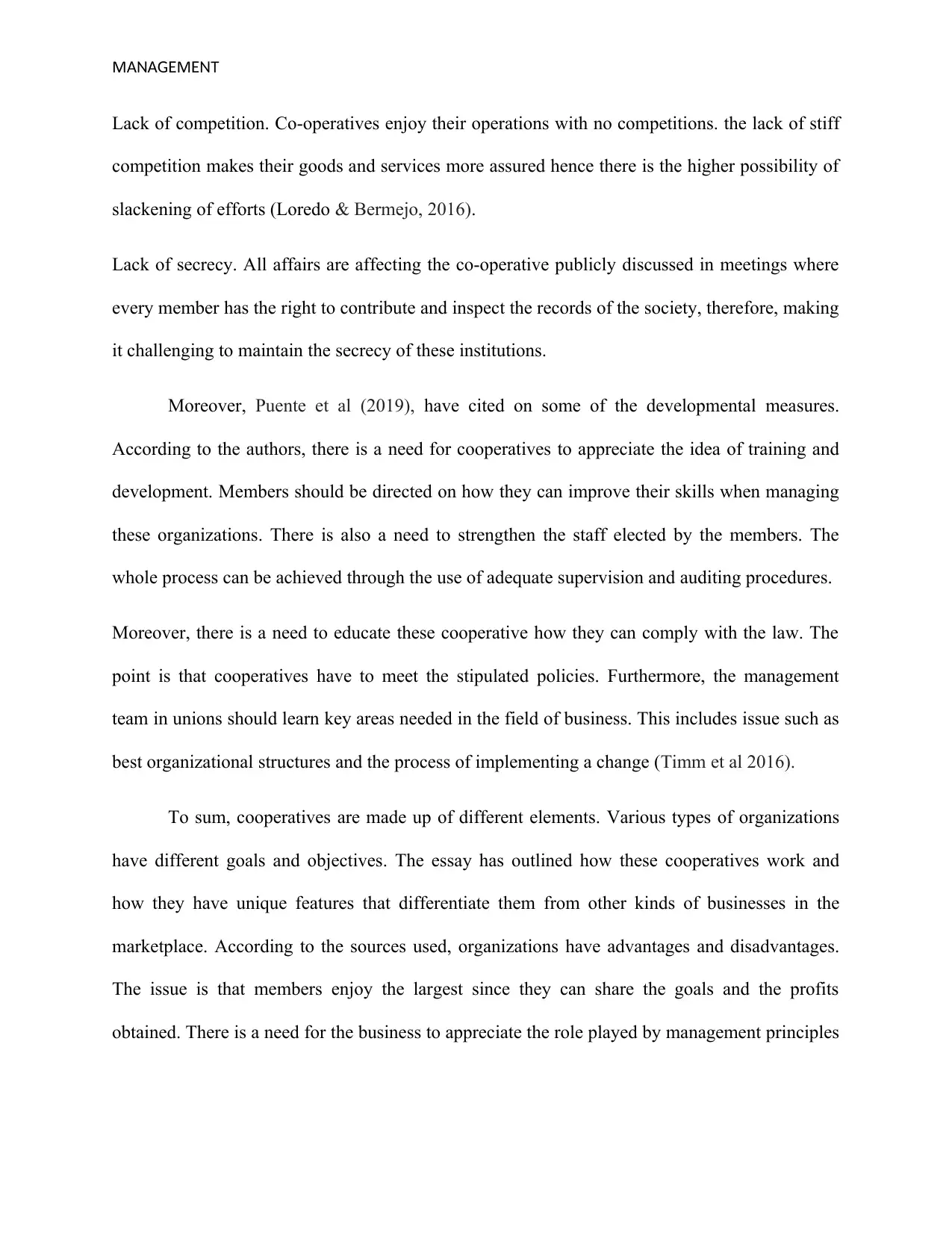
M M TANAGE EN
Lack of competition. Co-operatives enjoy their operations with no competitions. the lack of stiff
competition makes their goods and services more assured hence there is the higher possibility of
slackening of efforts (Loredo & Bermejo, 2016).
Lack of secrecy. All affairs are affecting the co-operative publicly discussed in meetings where
every member has the right to contribute and inspect the records of the society, therefore, making
it challenging to maintain the secrecy of these institutions.
Moreover, Puente et al (2019), have cited on some of the developmental measures.
According to the authors, there is a need for cooperatives to appreciate the idea of training and
development. Members should be directed on how they can improve their skills when managing
these organizations. There is also a need to strengthen the staff elected by the members. The
whole process can be achieved through the use of adequate supervision and auditing procedures.
Moreover, there is a need to educate these cooperative how they can comply with the law. The
point is that cooperatives have to meet the stipulated policies. Furthermore, the management
team in unions should learn key areas needed in the field of business. This includes issue such as
best organizational structures and the process of implementing a change (Timm et al 2016).
To sum, cooperatives are made up of different elements. Various types of organizations
have different goals and objectives. The essay has outlined how these cooperatives work and
how they have unique features that differentiate them from other kinds of businesses in the
marketplace. According to the sources used, organizations have advantages and disadvantages.
The issue is that members enjoy the largest since they can share the goals and the profits
obtained. There is a need for the business to appreciate the role played by management principles
Lack of competition. Co-operatives enjoy their operations with no competitions. the lack of stiff
competition makes their goods and services more assured hence there is the higher possibility of
slackening of efforts (Loredo & Bermejo, 2016).
Lack of secrecy. All affairs are affecting the co-operative publicly discussed in meetings where
every member has the right to contribute and inspect the records of the society, therefore, making
it challenging to maintain the secrecy of these institutions.
Moreover, Puente et al (2019), have cited on some of the developmental measures.
According to the authors, there is a need for cooperatives to appreciate the idea of training and
development. Members should be directed on how they can improve their skills when managing
these organizations. There is also a need to strengthen the staff elected by the members. The
whole process can be achieved through the use of adequate supervision and auditing procedures.
Moreover, there is a need to educate these cooperative how they can comply with the law. The
point is that cooperatives have to meet the stipulated policies. Furthermore, the management
team in unions should learn key areas needed in the field of business. This includes issue such as
best organizational structures and the process of implementing a change (Timm et al 2016).
To sum, cooperatives are made up of different elements. Various types of organizations
have different goals and objectives. The essay has outlined how these cooperatives work and
how they have unique features that differentiate them from other kinds of businesses in the
marketplace. According to the sources used, organizations have advantages and disadvantages.
The issue is that members enjoy the largest since they can share the goals and the profits
obtained. There is a need for the business to appreciate the role played by management principles
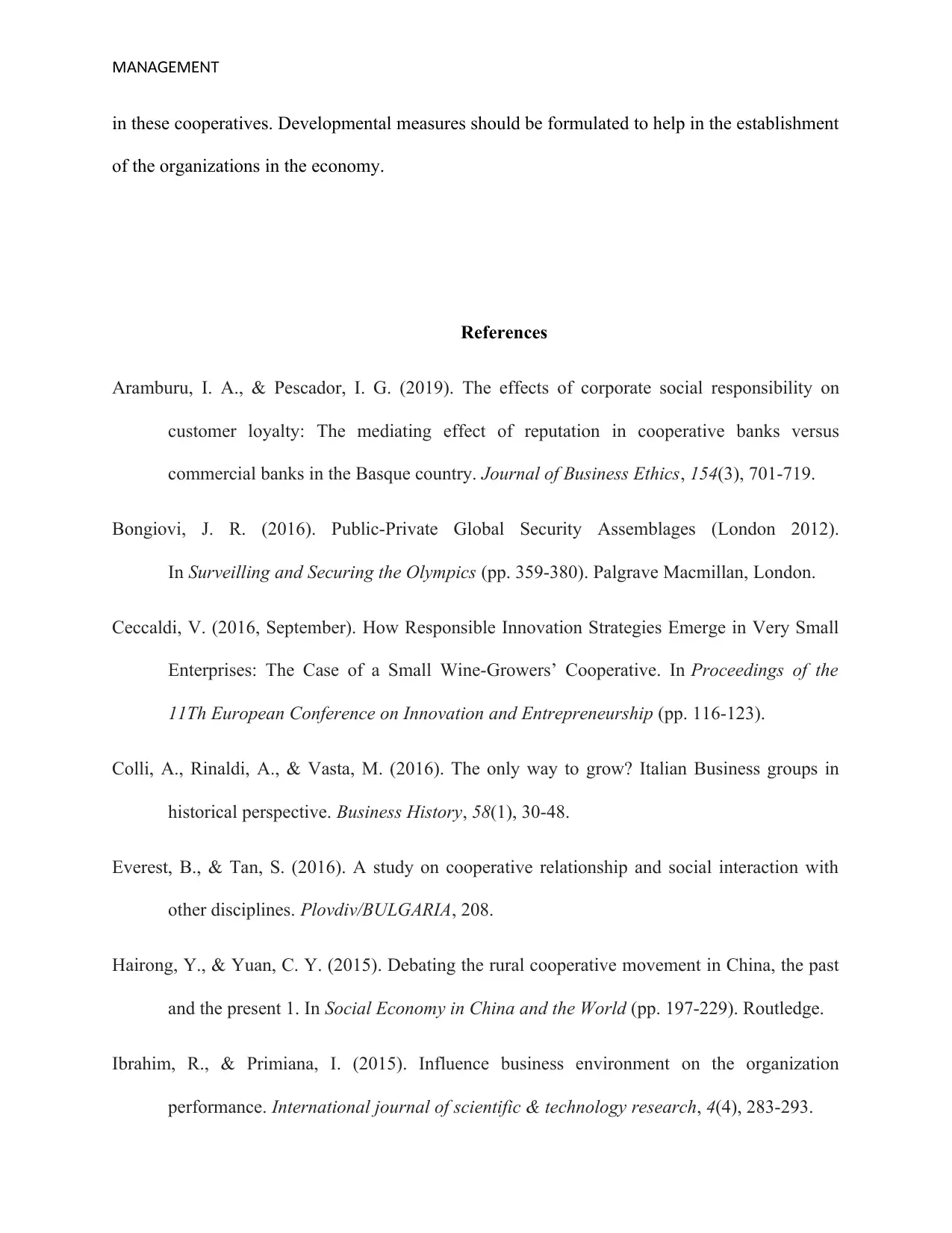
M M TANAGE EN
in these cooperatives. Developmental measures should be formulated to help in the establishment
of the organizations in the economy.
References
Aramburu, I. A., & Pescador, I. G. (2019). The effects of corporate social responsibility on
customer loyalty: The mediating effect of reputation in cooperative banks versus
commercial banks in the Basque country. Journal of Business Ethics, 154(3), 701-719.
Bongiovi, J. R. (2016). Public-Private Global Security Assemblages (London 2012).
In Surveilling and Securing the Olympics (pp. 359-380). Palgrave Macmillan, London.
Ceccaldi, V. (2016, September). How Responsible Innovation Strategies Emerge in Very Small
Enterprises: The Case of a Small Wine-Growers’ Cooperative. In Proceedings of the
11Th European Conference on Innovation and Entrepreneurship (pp. 116-123).
Colli, A., Rinaldi, A., & Vasta, M. (2016). The only way to grow? Italian Business groups in
historical perspective. Business History, 58(1), 30-48.
Everest, B., & Tan, S. (2016). A study on cooperative relationship and social interaction with
other disciplines. Plovdiv/BULGARIA, 208.
Hairong, Y., & Yuan, C. Y. (2015). Debating the rural cooperative movement in China, the past
and the present 1. In Social Economy in China and the World (pp. 197-229). Routledge.
Ibrahim, R., & Primiana, I. (2015). Influence business environment on the organization
performance. International journal of scientific & technology research, 4(4), 283-293.
in these cooperatives. Developmental measures should be formulated to help in the establishment
of the organizations in the economy.
References
Aramburu, I. A., & Pescador, I. G. (2019). The effects of corporate social responsibility on
customer loyalty: The mediating effect of reputation in cooperative banks versus
commercial banks in the Basque country. Journal of Business Ethics, 154(3), 701-719.
Bongiovi, J. R. (2016). Public-Private Global Security Assemblages (London 2012).
In Surveilling and Securing the Olympics (pp. 359-380). Palgrave Macmillan, London.
Ceccaldi, V. (2016, September). How Responsible Innovation Strategies Emerge in Very Small
Enterprises: The Case of a Small Wine-Growers’ Cooperative. In Proceedings of the
11Th European Conference on Innovation and Entrepreneurship (pp. 116-123).
Colli, A., Rinaldi, A., & Vasta, M. (2016). The only way to grow? Italian Business groups in
historical perspective. Business History, 58(1), 30-48.
Everest, B., & Tan, S. (2016). A study on cooperative relationship and social interaction with
other disciplines. Plovdiv/BULGARIA, 208.
Hairong, Y., & Yuan, C. Y. (2015). Debating the rural cooperative movement in China, the past
and the present 1. In Social Economy in China and the World (pp. 197-229). Routledge.
Ibrahim, R., & Primiana, I. (2015). Influence business environment on the organization
performance. International journal of scientific & technology research, 4(4), 283-293.
⊘ This is a preview!⊘
Do you want full access?
Subscribe today to unlock all pages.

Trusted by 1+ million students worldwide
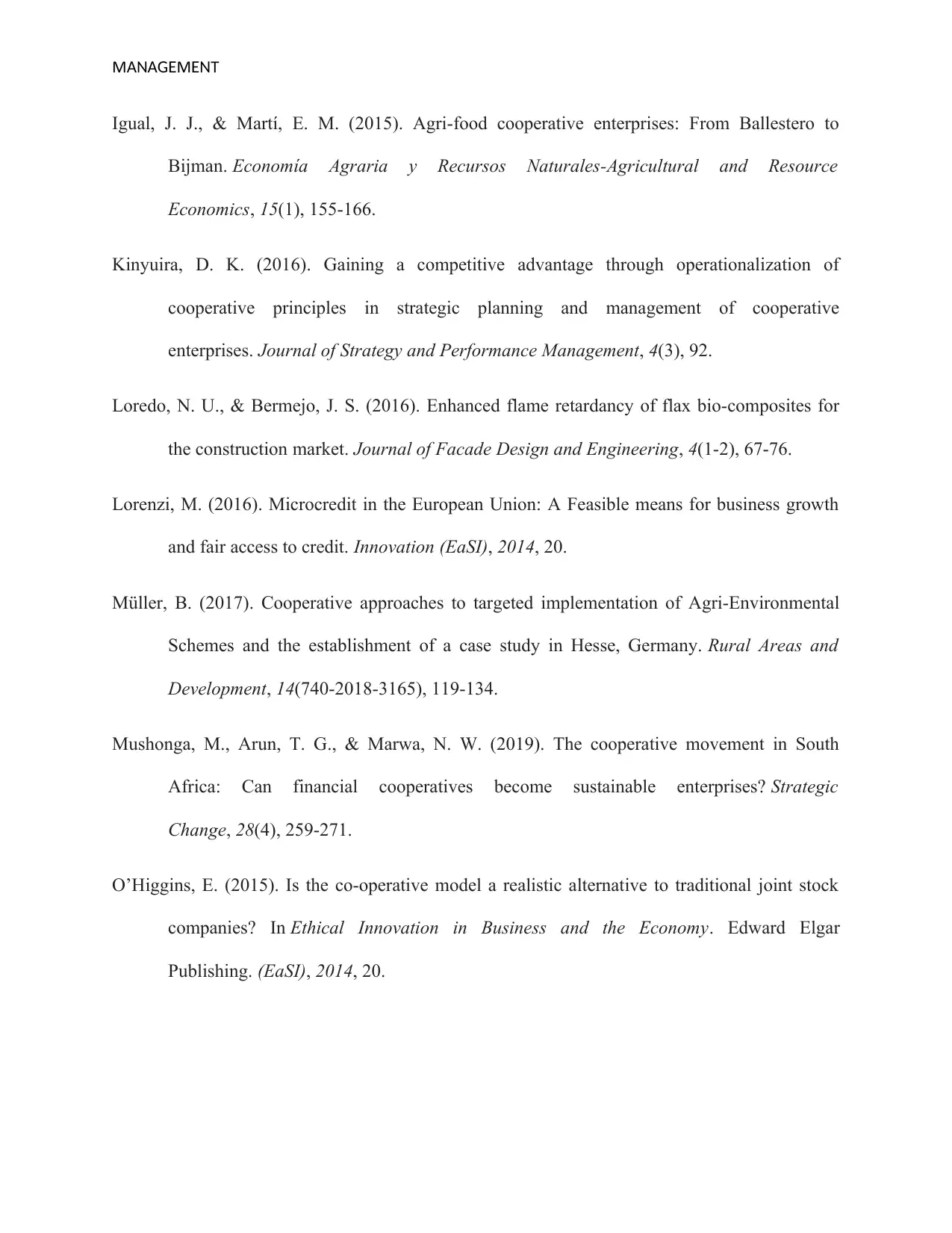
M M TANAGE EN
Igual, J. J., & Martí, E. M. (2015). Agri-food cooperative enterprises: From Ballestero to
Bijman. Economía Agraria y Recursos Naturales-Agricultural and Resource
Economics, 15(1), 155-166.
Kinyuira, D. K. (2016). Gaining a competitive advantage through operationalization of
cooperative principles in strategic planning and management of cooperative
enterprises. Journal of Strategy and Performance Management, 4(3), 92.
Loredo, N. U., & Bermejo, J. S. (2016). Enhanced flame retardancy of flax bio-composites for
the construction market. Journal of Facade Design and Engineering, 4(1-2), 67-76.
Lorenzi, M. (2016). Microcredit in the European Union: A Feasible means for business growth
and fair access to credit. Innovation (EaSI), 2014, 20.
Müller, B. (2017). Cooperative approaches to targeted implementation of Agri-Environmental
Schemes and the establishment of a case study in Hesse, Germany. Rural Areas and
Development, 14(740-2018-3165), 119-134.
Mushonga, M., Arun, T. G., & Marwa, N. W. (2019). The cooperative movement in South
Africa: Can financial cooperatives become sustainable enterprises? Strategic
Change, 28(4), 259-271.
O’Higgins, E. (2015). Is the co-operative model a realistic alternative to traditional joint stock
companies? In Ethical Innovation in Business and the Economy. Edward Elgar
Publishing. (EaSI), 2014, 20.
Igual, J. J., & Martí, E. M. (2015). Agri-food cooperative enterprises: From Ballestero to
Bijman. Economía Agraria y Recursos Naturales-Agricultural and Resource
Economics, 15(1), 155-166.
Kinyuira, D. K. (2016). Gaining a competitive advantage through operationalization of
cooperative principles in strategic planning and management of cooperative
enterprises. Journal of Strategy and Performance Management, 4(3), 92.
Loredo, N. U., & Bermejo, J. S. (2016). Enhanced flame retardancy of flax bio-composites for
the construction market. Journal of Facade Design and Engineering, 4(1-2), 67-76.
Lorenzi, M. (2016). Microcredit in the European Union: A Feasible means for business growth
and fair access to credit. Innovation (EaSI), 2014, 20.
Müller, B. (2017). Cooperative approaches to targeted implementation of Agri-Environmental
Schemes and the establishment of a case study in Hesse, Germany. Rural Areas and
Development, 14(740-2018-3165), 119-134.
Mushonga, M., Arun, T. G., & Marwa, N. W. (2019). The cooperative movement in South
Africa: Can financial cooperatives become sustainable enterprises? Strategic
Change, 28(4), 259-271.
O’Higgins, E. (2015). Is the co-operative model a realistic alternative to traditional joint stock
companies? In Ethical Innovation in Business and the Economy. Edward Elgar
Publishing. (EaSI), 2014, 20.
Paraphrase This Document
Need a fresh take? Get an instant paraphrase of this document with our AI Paraphraser

M M TANAGE EN
Puente, M. R., Arozamena, E. R., & Evans, S. (2015). Industrial symbiosis opportunities for
small and medium sized enterprises: preliminary study in the Besaya region (Cantabria,
Northern Spain). Journal of Cleaner Production, 87, 357-374.
Timm, I. J., Woelk, P. O., Knirsch, P., Tönshoff, H. K., & Herzog, O. (2016). Flexible mass
customisation: managing its information logistics using adaptive cooperative multi-agent
systems. In Developments in Logistics and Supply Chain Management (pp. 203-211).
Palgrave Macmillan, London.
Puente, M. R., Arozamena, E. R., & Evans, S. (2015). Industrial symbiosis opportunities for
small and medium sized enterprises: preliminary study in the Besaya region (Cantabria,
Northern Spain). Journal of Cleaner Production, 87, 357-374.
Timm, I. J., Woelk, P. O., Knirsch, P., Tönshoff, H. K., & Herzog, O. (2016). Flexible mass
customisation: managing its information logistics using adaptive cooperative multi-agent
systems. In Developments in Logistics and Supply Chain Management (pp. 203-211).
Palgrave Macmillan, London.
1 out of 11
Your All-in-One AI-Powered Toolkit for Academic Success.
+13062052269
info@desklib.com
Available 24*7 on WhatsApp / Email
![[object Object]](/_next/static/media/star-bottom.7253800d.svg)
Unlock your academic potential
Copyright © 2020–2025 A2Z Services. All Rights Reserved. Developed and managed by ZUCOL.